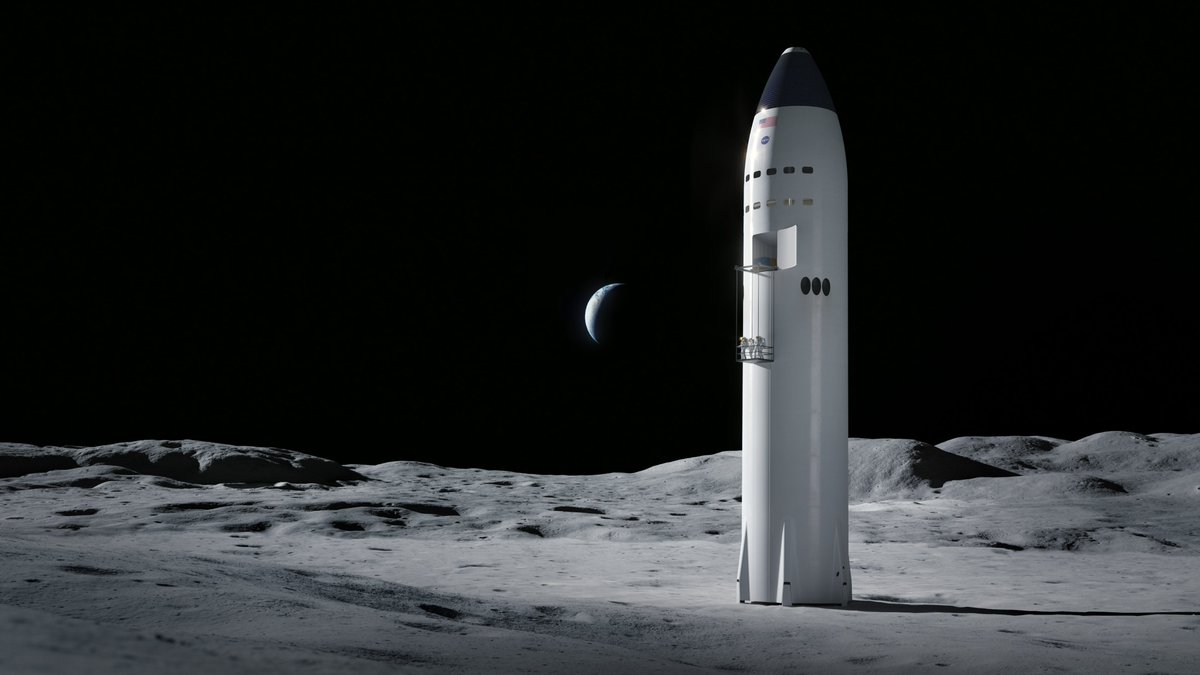NASA picks SpaceX's Starship to land Artemis astronauts on the moon
The company beat out competitors Blue Origin and Dynetics.

It's official: SpaceX will be building the spacecraft that will land NASA astronauts on the moon.
In 2020, NASA awarded contracts to three commercial teams — SpaceX, Dynetics and Blue Origin — for the agency's Human Landing System (HLS) program. They asked each of these companies to develop an innovative landing system to be used under the Artemis program to ferry astronauts down to the lunar surface.
On Friday (April 16), NASA announced that SpaceX's Starship had beat out the other two competitors, winning the $2.9 billion contract to build the Artemis lunar lander.
"We have awarded SpaceX to continue the development of our integrated human landing system," Lisa Watson-Morgan, HLS program manager, said during a news conference Friday (April 16). "We're confident in NASA's partnership with SpaceX to help us achieve the Artemis mission and look forward to continuing our work toward landing astronauts on the moon, to prepare for the next giant leap towards Mars."
Related: NASA unveils plan for Artemis 'base camp' on the moon beyond 2024
With its Artemis program, NASA aims to land the first woman and the first person of color to land on the moon. This will be the first time humans will walk on the moon since 1972, with the final lunar landing mission of NASA's Apollo program.
But "this time ... our goal is to return to the moon in a sustainable way to gain insight and bring back lessons that will help propel us into greater exploration that's never been done before," Kathy Lueders, associate administrator for NASA’s Human Exploration and Operations Mission Directorate, said during the news conference.
Get the Space.com Newsletter
Breaking space news, the latest updates on rocket launches, skywatching events and more!
"When NASA returns to the moon with Artemis program, it will go in a way that reflects the world today," Leuders said.
This goal was set to happen by 2024 under the Trump administration but the Biden administration has not yet specified whether it will stick to this very ambitious deadline.
"The NASA team will have the insight into the progress that SpaceX is making and if they're hitting their milestones we may have a shot at 2024," acting NASA Administrator Steve Jurczyk said during the conference.
More: SpaceX's Starship and Super Heavy rocket in pictures
NASA was expected to choose two of the three companies in the running to build the lander, as the agency often has multiple providers to ensure a backup and to keep the energy of competition. However, they have chosen to go ahead with SpaceX alone.
While NASA wanted "to preserve a competitive environment at this stage of the HLS Program," the agency said in a document obtained by The Washington Post, there were budgetary concerns. In response, SpaceX updated the cost of their lander to fit "within NASA's current budget."
When asked if, down the road, NASA might reevaluate having a second company build a lunar lander, Jurczyk said that "we're moving forward. We don't anticipate revisiting this selection."
The $2.9 billion contract carries roughly 13% of the amount that NASA's lunar module would have cost for the agency's Apollo program, which would have cost about $23 billion in 2020, Casey Dreier, Chief Advocate & Senior Space Policy Advisor at The Planetary Society, estimated on Twitter.
For its lunar lander design, SpaceX has pitched a variation on its Starship spacecraft. SpaceX is already on its 15th Starship prototype and has been regularly testing the craft. Many of the prototypes have so far crashed and exploded, with SN10, its 10th Starship prototype being the first to land (though it exploded shortly after landing).
"Just from the human landing system standpoint, we had 27 functional performance requirements that we asked the offers, including SpaceX, to respond to," Watson-Morgan told Space.com during the conference.
"And we went through a very detailed design, technical design, construction standards, safety, as well as health and human performance work, and all of that was pulled together, and that shifted, various aspects of their Starship ... they were able to meet or exceed the items that we had that we require for safe human landing," Watson-Morgan added.
The company is developing Starship to one day carry humans and cargo to the moon, Mars and even more distant destinations, launching the craft aboard the company's Super Heavy rocket. NASA announced today that Super Heavy will launch Starship to the moon as part of the Artemis program.
During this news conference, NASA also announced another competition, this time for commercial transportation services to help make human exploration of the moon more sustainable.
"We're accelerating what we call the human lunar landing services procurement. This competition will provide regularly returning services to the lunar surface that will enable these crewed missions on a sustainable basis," Mark Kirasich, deputy associate administrator for NASA's Advanced Exploration Systems division, said.
More details on this newly-announced contest are to come.
Email Chelsea Gohd at cgohd@space.com or follow her on Twitter @chelsea_gohd. Follow us on Twitter @Spacedotcom and on Facebook.
Join our Space Forums to keep talking space on the latest missions, night sky and more! And if you have a news tip, correction or comment, let us know at: community@space.com.

Chelsea “Foxanne” Gohd joined Space.com in 2018 and is now a Senior Writer, writing about everything from climate change to planetary science and human spaceflight in both articles and on-camera in videos. With a degree in Public Health and biological sciences, Chelsea has written and worked for institutions including the American Museum of Natural History, Scientific American, Discover Magazine Blog, Astronomy Magazine and Live Science. When not writing, editing or filming something space-y, Chelsea "Foxanne" Gohd is writing music and performing as Foxanne, even launching a song to space in 2021 with Inspiration4. You can follow her on Twitter @chelsea_gohd and @foxannemusic.









